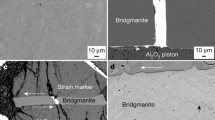Abstract
CARTER1 has reviewed advances in understanding the steady-state flow of rocks with particular reference to the behaviour and anisotropic alignment of rocks in the upper mantle. Some form of high-temperature creep is clearly responsible for the distribution of continents and their first-order structures2. The difficulty is specifying the exact mechanism and the possible anisotropic alignments. Appropriate upper mantle temperatures and pressures can be achieved in the laboratory3, but any results must be extrapolated to rates of deformation lower by some five or six orders of magnitude. Carter et al.2 conclude, although there are conflicting views4, that the syntectonic recrystallisation suggested by Avé Lallemant and Carter5 is the dominant deformational process. This will be most effective at the higher temperatures at the base of the lithosphere where crystals, orientated by the deformations, have their alignments fixed as the lithosphere cools. All the deformational processes suggested for the upper mantle are capable of orientating crystalline structures, and aligned azimuthal-anisotrophy may be expected at any depth in the lithosphere.
Similar content being viewed by others
References
Carter, N. L. Rev. geophys. Space Phys. 14, 301–360 (1976).
Carter, N. L., Baker, D. W. & George, R. P. Flow and fracture of rocks Geophys. Mono. Ser. 16, 167–190 (1972).
Peselnick, L. & Stewart, R. M. J. geophys. Res. 80, 3765–3768 (1975).
Peselnick, L., Nicolas, A. & Stevenson, P. R. J. geophys. Res. 79, 1175–1182 (1974).
Avé Lallemant, H. G. & Carter, N. L. Am. J. Sci. 270, 218–235 (1971).
Peselnick, L., Lockwood, J. P. & Stewart, R. J. geophys. Res. 82, 2005–2010 (1977).
Bamford, D. & Crampin, S. Geophys. J. R. astr. Soc. 49, 1–8 (1977).
Bamford, D. Geophys. J. R. astr. Soc. 49, 29–48 (1977).
Forsyth, D. W. Geophys. J. R. astr. Soc. 43, 103–162 (1975).
Crampin, S. & King, D. W. Geophys. J.R. astr. Soc. 49, 59–85 (1977).
Hess, H. H. Nature 203, 629–631 (1964).
Francis, T. J. G. Nature 221, 161–165 (1969).
Crampin, S. Geophys. J. R. astr. Soc. 49, 9–27 (1977).
Keith, C. M. & Crampin, S. Geophys. J. R. astr. Soc. 49, 225–243 (1977).
Author information
Authors and Affiliations
Rights and permissions
About this article
Cite this article
CRAMPIN, S. Palaeoanisotropy in the upper mantle. Nature 270, 162–163 (1977). https://doi.org/10.1038/270162a0
Received:
Accepted:
Issue Date:
DOI: https://doi.org/10.1038/270162a0
- Springer Nature Limited





